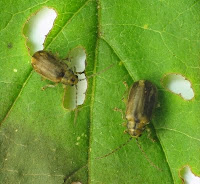 |
| Queen Anne's lace and many visitors. What is it replacing? |
I worry sometimes when people insist on seeing the merits of some introduced plant and claim that it is good for wildlife. We are all familiar with butterfly bush attracting butterflies and with the berries and rose hips of several alien plants which feed the birds. I have also seen Queen Anne’s lace blossoms covered with flower visitors. Another example is this blog article about English ivy and pollinators: Pollinators aplenty: English Ivy mixed blessings. The author tells us that the English ivy in his property is attracting numerous pollinators at a time when there aren’t any native flowers. He suggests that we “should step back and view non-natives with less disdain until we understand better what roles they now play in their adopted habitats.”
I think that this philosophy shows a lack of understanding of ecosystems and of what is missing in those that have been altered by humans. We tend to think that habitat loss is something far away, clear-cutting in the Amazon, for instance. We seem to forget that the urbanization and suburbanization of the areas where most of us live are representatives of a huge amount of habitat loss.
When pollinators and birds resort to non-native flowers and berries, it is because the habitat has been severely disturbed and the native plants that were supposed to sustain them are lacking. A healthy habitat is an assemblage of co-evolved and synchronized plants and the wildlife that feed on them. The absence of such plants is a very sad indication that the ecosystem has been dramatically disrupted.
Calling non-native plants beneficial to wildlife is ludicrous. They are merely acting as prosthesis. If I had a leg amputated, I too would sing the praises of a high quality prosthesis, no matter how alien to my body it was. But, I would prefer my own, native and co-evolved with my body, original leg.
 |
|
Butterfly bush provides nectar to butterflies but very
little else, unlike many native plants
|
More on the subject: I do not hate invasive species
List of articles











